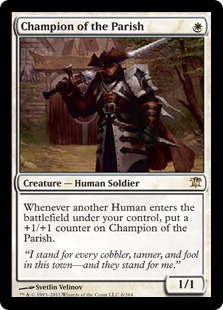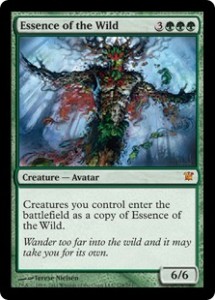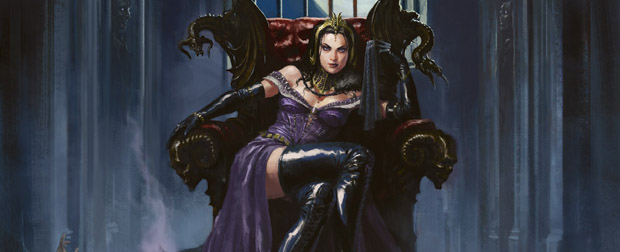I had an Al Pacino moment the other day. After a seven year furlough, I started playing Magic: the Gathering again (“just when I thought I was out… they pulled me back in!”). I played very heavily through the Masques, Invasion, Odyssey, and Onslaught blocks, leaving around the time of Mirrodin but still playing casually with the cards I had accumulated. Along came Duels of the Planeswalkers 2012 during the Steam holiday sales, and to make a long story short, my roomies and I just bought a booster box of Innistrad and I’m back in force.
Something struck me about the state of the game though: how much the going price of a specific card can influence how willing I am to trade it. This isn’t a comment on M:tG or Innistrad itself (though it’s a fantastic set) so much as how things have naturally progressed with the proliferation of smart phones and recent Internet trends. Nowadays it’s MUCH easier to establish a going price for a certain card by checking sites such as TCGPlayer or even Amazon. And with smart phone applications like M:tG Tracker, these prices are readily available for Magic enthusiasts on the go. At a Friday Night Magic tourney and want to trade cards? Well, with these apps you can make sure you’re getting a fair deal.
But who decides what’s ‘fair’? What influences the going rate of a card? The obvious answers would be ‘however good the card is’, or ‘however rare it is’ – but neither of these is really the case. Sure, collectors will pay more for a rare card, but this applies more to classic cards like Black Lotus rather than your super rare card from a block that just got phased out of the standard tournament rotation. As for the quality of the card – very rarely can one card win things for you. What matters is how well it fits into a deck.
There’s the key. The biggest factor in a card’s value is how it plays into the current meta game (a lovely term pertaining to how people play a game and the popular trends within it).
 Let’s explore that a bit. Say I have a card which, on its own merits, wouldn’t normally make much of an impact. I’ll go with Champion of the Parish, from Innistrad. It’s a weak creature that gets stronger the more Human creatures you play. Not bad, all told, but it’s certainly not going to win any games for you unless you stack your deck with Human creatures.
Let’s explore that a bit. Say I have a card which, on its own merits, wouldn’t normally make much of an impact. I’ll go with Champion of the Parish, from Innistrad. It’s a weak creature that gets stronger the more Human creatures you play. Not bad, all told, but it’s certainly not going to win any games for you unless you stack your deck with Human creatures.
Well, my friends, guess what’s popular in the current meta game? Keep in mind I’ve only been back to playing for about a week at the time of writing this, but I’ve gathered after thorough research and with my keen instincts developed from years of M:tG experience that Human decks are indeed quite popular right now. That means there are plenty of people playing decks with lots of juicy Human creatures in them, and therefore plenty of people who’d like to get their hands on a few copies of Champion of the Parish to beat their opponents over the head (figuratively, not literally). Assuming my knowledge of basic economics holds true, that would in turn drive the price of said card up. They’re running about $4 apiece at this moment, if you’d care to know.
 Now let’s look at another card, a card which seemingly would have more impact on a game and therefore be worth much more. Let’s pick Essence of the Wild, a Mythic Rare from Innistrad. A Mythic Rare is a card that has been designated as particularly powerful and rare. Out of 36 packs in my Innistrad box, I opened six Mythic Rares (one of which was a foil, which I understand is quite lucky), smiling as I reaped the benefits of being a Rabbit of Irish ancestry. The bottom line is, with their rarity and perceived quality, Mythic Rares should be among the most expensive cards in a set. Hell, Essence of the Wild is a big, beefy creature with a low mana cost that turns all other creature spells you cast into big, beefy creatures.
Now let’s look at another card, a card which seemingly would have more impact on a game and therefore be worth much more. Let’s pick Essence of the Wild, a Mythic Rare from Innistrad. A Mythic Rare is a card that has been designated as particularly powerful and rare. Out of 36 packs in my Innistrad box, I opened six Mythic Rares (one of which was a foil, which I understand is quite lucky), smiling as I reaped the benefits of being a Rabbit of Irish ancestry. The bottom line is, with their rarity and perceived quality, Mythic Rares should be among the most expensive cards in a set. Hell, Essence of the Wild is a big, beefy creature with a low mana cost that turns all other creature spells you cast into big, beefy creatures.
That card is a beast, right? At least that’s what I thought when I opened it in one of my booster packs.
A card’s value is dictated primarily by its popularity in the current meta game. As it turns out, as beastly as it may seem, Essence of the Wild isn’t really used in any popular decks right now. A voice in the back of my head is raging: “But it’s such a strong card! And it’s rare! Rarer than Rare!” Well cue the sad trombone, because the going price for Essence of the Wild is currently about $1 (womp, wooooomp).
If we go by those numbers, then in order to get a ‘fair’ deal I’d have to trade FOUR copies of Essence of the Wild to get ONE copy of Champion of the Parish. God help the snot-nosed little brat at a Magic tourney who might propose that trade to me. I’m all for getting a fair deal, but in no way am I going to trade four Mythic Rares for one Rare just because it is popular in the current meta game. Not happening. And of course I have to acknowledge that there’s always been that kind of dynamic when trading when some cards were considered inherently more valuable because of popularity. But that was just a ‘general knowledge’ kind of thing without any hard numbers – now you can get an exact price within 30 seconds just by pulling out your phone!
I’m not going to say this is a good thing or a bad thing. I’m more of a True Neutral type anyway (if you dig your old school D&D), so I try to see everything in shades of grey. I wouldn’t mind knowing how much my cards are worth – and if I’m not that familiar with (or charitable towards) someone, then I’m much more likely to hold close to those values. But when one of my roomies or homeboys want to trade their $0.60 Falkenreath Marauders for my $4.60 Bloodline Keeper, I’ll probably do so with the stinging awareness that I got a raw deal. Such is the price of technological progress…


This is also where selling your popular and expensive cards to places like Card Kingdom or other popular singles retailers comes in handy. I buy singles just because I like to play with all sets and not the current stuff. I don’t have the time nor the money to be playing every current set and playing in a lot of drafts.
That said, popular meta game cards used in tournaments also determine what cards get banned or restricted as well.
I got back into MtG in Sept. of 2010, and now I am getting into other TCGs.
Great read, now I want to play again
Got into playing right at the start of Mirrodin, but lost interest around the second batch of Kamigawa. I was amazed at how these cards were priced, and the effect price seemed to have. People look down on ‘cheap’ rares for no apparent reason, but there are so many cards available that you can build decks around pretty much anything. Always surprised to see people judge your deck based on the number of you don’t have any fancy rares in them.
http://magiccards.info/5dn/en/32.html has got to be my favorite under-rated rare of all time (that I know of). I had a combo built around that, and it was incredibly effective 😀
I like to go for low casting cost commons and uncommons myself. Sometimes those can be a bit pricy since everyone is using them in their decks. Remember it is economics and that can be a pain. I had to wait on a couple of cards because the place I was buying them from were out of stock (I have since gotten the cards from them). I got in right at the end of Invasion/ start of Odyssey, and I stopped playing when 8th edition was coming out (didn’t like the card layout, and friends stopped playing).